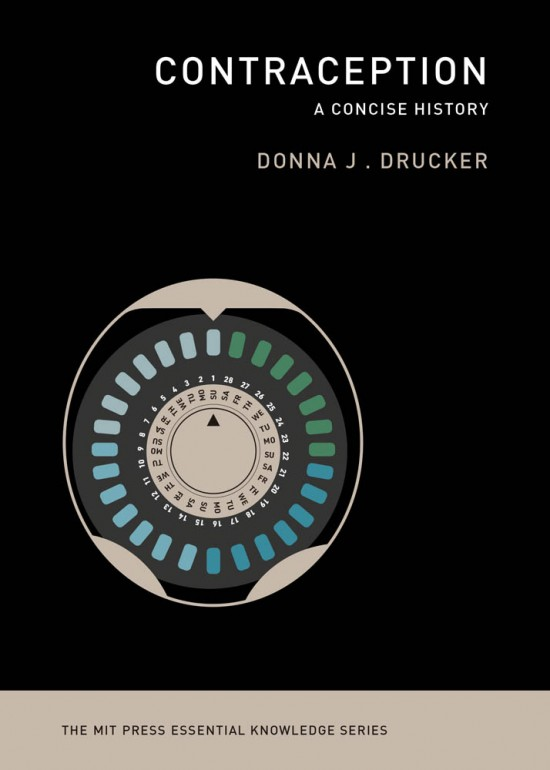Contraception: A Concise History traces the technological history of contraceptive methods across the world from the opening of the first public women’s contraceptive clinic in 1882 to the present. It focuses on how the availability or unavailability of technology influences public policy, religious directives, community and family norms, and the behaviors of individuals and couples. It interweaves the history of technology, the gendered history of family and reproductive decision-making, and the history of sexuality into a single narrative centered on the specific devices and behaviors used to control fertility.

NOTCHES: In a few sentences, what is your book about? Why will people want to read your book?
Drucker: The book centers on research, development, manufacturing, sales, distribution, and use of contraceptive technology from 1882 through the present and identifies individuals whose contributions to contraceptive history were critical to defining the contraceptive landscape today. Readers will be interested in it because it is the only survey of the history of contraception in English published since Robert Jütte’s Contraception, A History (2003/ trans. 2008) and Angus McLaren’s A History of Contraception (1992). It brings the history of contraception up to 2019 and draws on theories of reproductive justice as a framework for analysis.
NOTCHES: What drew you to this topic, and what questions do you still have?
Drucker: I was drawn to this topic by its nonappearance in Alfred C. Kinsey’s two major volumes, Sexual Behavior in the Human Male (1948) and Sexual Behavior in the Human Female (1953). Kinsey (1894–1956) received both praise and criticism in his lifetime and afterward for focusing on human sexual behavior itself. However, given that contraception in the pre-Pill era was not failsafe, and women (and others with uteri) would often want to prevent pregnancy, especially when extramarital sex was illegal, why wouldn’t contraception play a role in sexual decision-making? Its near-total absence in Kinsey’s analysis was puzzling, so I decided to dig into the topic further.
It is still unclear where the now-universal “typical use” vs. “perfect use” framework for evaluating contraceptive effectiveness comes from. It may originate in the work of Dr. Hannah Stone (1894–1956), who was one of the first gynecologists to keep simple statistics of contraceptive use and non-use among her patients in New York and New Jersey. The construction of the “typical user” and “perfect user” highlights an ongoing tension in contraceptive technology over who or what is to blame when a contraceptive fails.
NOTCHES: This book is about the history of sex and sexuality, but what other themes does it speak to?
Drucker: Contraception addresses three themes: first, it shows how individual, national, and international ideas about gender, marriage, reproduction, and eugenics are identifiable through the lens of seemingly unremarkable common objects, like condoms and spermicides. Second, it illustrates that the availability or unavailability of different contraceptive methods, reliable information about contraception, and the amount of public funding for research on contraception are indicators of a country’s commitment to women’s and human rights. Third, it highlights the importance of the history of technology for the more recent history of reproductive justice, along with potentialities for new contraceptives in the future—particularly for nonbinary and transpeople.
NOTCHES: Were there any highlights during research for the book?
Drucker: One highlight of researching this book was travelling to Washington, DC in 2017 to study at the National Museum of American History (NMAH), Smithsonian Institution. I received a travel-to-collections grant from the Lemelson Center, which allowed me to visit the Archives Center, the NMAH Library, and material culture in the Division of Science and Medicine for two weeks. When the material culture curator opened a drawer with contraceptive objects, she showed me a Dalkon Shield IUD still in its package. I jumped a foot, knowing that how much pelvic damage the device had caused so many women. Its shape is so sinister—I still get shivers thinking about it.
NOTCHES: Whose stories or what topics were left out of your book and why?
Drucker: The history of contraception is often focused on innovation and innovators, along with the voices of its loudest advocates, but not on the people that it most impacts: the users. Before the 1970s, there was little public discussion of contraception among users and in public forums. How users felt about different kinds of contraceptives is mainly captured either in letters to advocates like Dr. Marie Stopes (1880–1958) in the UK or through the reports of physicians like Dr. Robert Latou Dickinson (1861–1950) in the US. It is hard to know what people really thought and felt without the intervention or voices of experts. In the absence of more primary sources on how people felt about using contraception, I drew on fiction as a source of everyday practice and emotions.
The book is not as wholly global as I would have liked it to be. I wish that I could have included more historical material on contraception and fertility limitation practices in central Asia, southeast Asia, and the Pacific Islands. Material on those countries is either not available, or I simply did not find it.
NOTCHES: How did you become interested in the history of sexuality?
Drucker: I did my graduate work at Indiana University, where the Kinsey Institute is located. I took a class from the professor who became my advisor, Judith A. Allen, on the history of sex research. The class took place in spring 2003, which coincided with a major interdisciplinary conference that Allen and other KI–affiliated faculty planned to mark the fiftieth anniversary of Alfred Kinsey’s Sexual Behavior in the Human Female (1953). When the original conference planner was unable to complete the work, I took over managing the three-hundred-person conference myself. As a result of that conference, and meeting so many interesting people studying sexuality from interesting and diverse angles, I decided that I would write my PhD dissertation on Kinsey’s intellectual history from his gall wasp studies through the Female volume. So I did, and my interest in the intersection of gender and sexuality with science and technology has remained strong ever since.
NOTCHES: How do you see your book being most effectively used in the classroom? What would you assign it with?
Drucker: Some friends and colleagues have assigned it in classes on the history of reproduction, history of medicine, and the history of women, gender, and sexuality. It has not been assigned in classes on the history of technology, as far as I know. In a women’s history or reproduction history course, I would assign it next to recent books on contraceptive history such as Caroline Rusterholz’s Women’s Medicine (2020), Claire L. Jones’s The Business of Birth Control (2020), and Jessica Borge’s Protective Practices (2020). Each of those books provides a deep dive into contraceptive history in the UK (and in Rusterholz’s case, a comparison with France), and my book provides a global and longer chronological context for the specific happenings in them.
NOTCHES: Why does this history matter today?
Drucker: As Norman E. Himes wrote in his now-classic 1936 book Medical History of Contraception, “men and women have always longed for both fertility and sterility, each at its appointed time and in its chosen circumstances” (xii). Fertility, sexuality, and kinship ties have all been central to the organization and management of human societies for millennia. The availability of new technologies to have children (or to avoid doing so) shifts the dimensions of how those ties manifest and keeps them central to the question of what a family is.
NOTCHES: Your book is published, what next?
Drucker: I have a contract with MIT Press to publish another Essential Knowledge series book on fertility technology, so I am now researching technologies related to making pregnancy happen, rather than avoiding or postponing it. It has been fascinating to study both contraceptive and fertility technology, and to have the opportunity to think broadly about both kinds of technology in the history of reproduction.

Donna J. Drucker is Assistant Director of the Office of Scholarship and Research Development at the Columbia University School of Nursing. She is the author of The Machines of Sex Research, The Classification of Sex, Contraception, and Fertility Technology. She tweets from @histofsex

NOTCHES: (re)marks on the history of sexuality is licensed under a Creative Commons Attribution-NonCommercial-NoDerivatives 4.0 International License.
Based on a work at www.notchesblog.com.
For permission to publish any NOTCHES post in whole or in part please contact the editors at NotchesBlog@gmail.com




